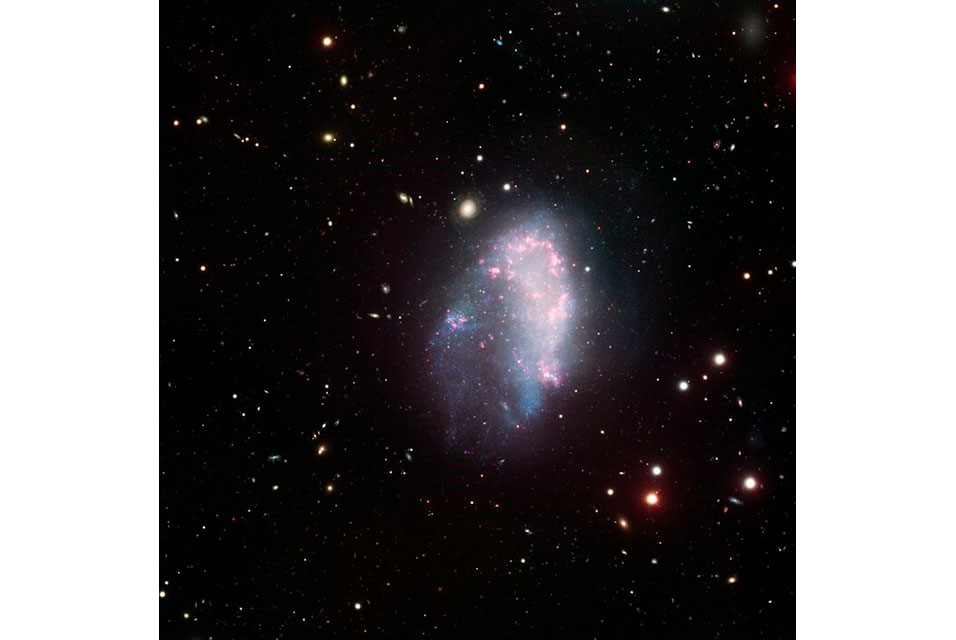BONN.- According to the standard model of cosmology, the vast majority of galaxies are surrounded by a halo of dark matter particles. This halo is invisible, but its mass exerts a strong gravitational pull on galaxies in the vicinity. A new study led by the
University of Bonn (Germany) and the University of Saint Andrews (Scotland) challenges this view of the Universe. The results suggest that the dwarf galaxies of Earth's second closest galaxy cluster—known as the Fornax Cluster—are free of such dark matter halos. The study appeared in the journal Monthly Notices of the Royal Astronomical Society.
Dwarf galaxies are small, faint galaxies that can usually be found in galaxy clusters or near larger galaxies. Because of this, they might be affected by the gravitational effects of their larger companions. "We introduce an innovative way of testing the standard model based on how much dwarf galaxies are disturbed by gravitational ,tides' from nearby larger galaxies," said Elena Asencio, a Ph.D. student at the University of Bonn and the lead author of the story. Tides arise when gravity from one body pulls differently on different parts of another body. These are similar to tides on Earth, which arise because the moon pulls more strongly on the side of Earth which faces the moon.
The Fornax Cluster has a rich population of dwarf galaxies. Recent observations show that some of these dwarfs appear distorted, as if they have been perturbed by the cluster environment. "Such perturbations in the Fornax dwarfs are not expected according to the Standard Model," said Pavel Kroupa, professor at the University of Bonn and Charles University in Prague. "This is because, according to the standard model, the dark matter halos of these dwarfs should partly shield them from tides raised by the cluster."
The authors analyzed the expected level of disturbance of the dwarfs, which depends on their internal properties and their distance to the gravitationally powerful cluster center. Galaxies with large sizes but low stellar masses and galaxies close to the cluster center are more easily disturbed or destroyed. They compared the results with their observed level of disturbance evident from photographs taken by the VLT Survey Telescope of the European Southern Observatory.
Elena Asencio says that "the comparison showed that, if one wants to explain the observations in the standard model. The Fornax dwarfs should already be destroyed by gravity from the cluster center even when the tides it raises on a dwarf are sixty-four times weaker than the dwarf's own self-gravity." Not only is this counter-intuitive, she said, it also contradicts previous studies, which found that the external force needed to disturb a dwarf galaxy is about the same as the dwarf's selfgravity.
Contradiction to the standard model
From this, the authors concluded that, in the standard model, it is not possible to explain the observed morphologies of the Fornax dwarfs in a self-consistent way. They repeated the analysis using Milgromian dynamics (MOND). Instead of assuming dark matter halos surrounding galaxies, the MOND theory proposes a correction to Newtonian dynamics by which gravity experiences a boost in the regime of low accelerations.
"We were not sure that the dwarf galaxies would be able to survive the extreme environment of a galaxy cluster in MOND, due to the absence of protective dark matter halos in this model," said Dr. Indranil Banik from the University of St Andrews. "But our results show a remarkable agreement between observations and the MOND expectations for the level of disturbance of the Fornax dwarfs."
"It is exciting to see that the data we obtained with the VLT survey telescope allowed such a thorough test of cosmological models," said Aku Venhola from the University of Oulu (Finland) and Steffen Mieske from the European Southern Observatory, co-authors of the study.
This is not the first time that a study testing the effect of dark matter on the dynamics and evolution of galaxies concluded that observations are better explained when they are not surrounded by dark matter. "The number of publications showing incompatibilities between observations and the dark matter paradigm just keeps increasing every year. It is time to start investing more resources into more promising theories," said Pavel Kroupa, member of the transdisciplinary research areas modeling and matter at the University of Bonn.
Dr. Hongsheng Zhao from the University of St Andrews added that their "results have major implications for fundamental physics. We expect to find more disturbed dwarfs in other clusters, a prediction which other teams should verify."










